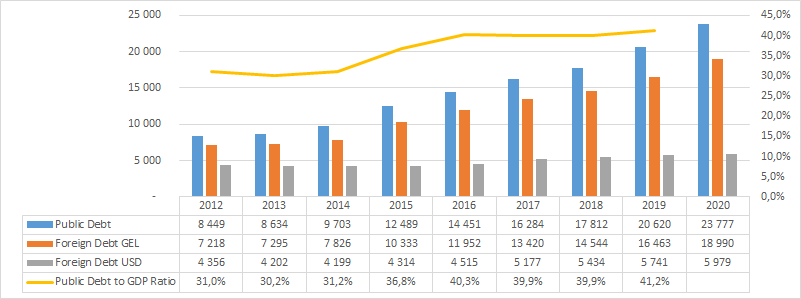Resume:
The absolute figure of the public debt in 2020 increased 2.8 times as compared to 2012; that is, by nearly GEL 15 billion. However, the GEL exchange rate changes in the past years also need to be taken into account since it affects GEL-denominated debt figures. In turn, the fluctuation of the currency exchange rate which started at the end of 2014 and caused a hike in GEL-denominated debt was largely stipulated by factors upon which the authorities lacked any leverage. Nonetheless, certain actions or inactions of the Government of Georgia did undoubtedly have an additional negative impact on the depreciation of the currency exchange rate. The USD-denominated foreign debt in that period increased 1.4 times from USD 4.3 billion to USD 6 billion, although the GEL-denominated debt figure increased 2.6 times from GEL 7.2 billion to GEL 19 billion as a result of the fluctuation of the currency exchange rate.
Giorgi Vashadze almost fully accurately states the figures, although he disregards an important factor (the change in the currency exchange rate) which stipulated the difference in debt and could have given him a different conclusion had he taken this factor into account. In addition, the accepted form of data analysis is also ignored. In particular, Mr Vashadze makes emphasis on the absolute instead of relative figure which shows the debt growth to be exaggerated as compared to what it actually is.
Analysis
On the talk show 360 Degrees on air on TV PalitraNews, the leader of the New Georgia party, Giorgi Vashadze, stated (46:05): “In 2012 when the Georgian Dream came to power, the foreign debt was nearly GEL 7-8 billion. Today, our debt is GEL 23 billion. Does this country look like GEL 15 billion made any difference?”
The Georgian Ministry of Finance publishes statistical information on Georgia’s public debt. This article discusses the total public debt which is the sum of the government debt and the National Bank’s debt. The public debt and the government debt in this period had a similar dynamic. In addition, the analysis does not include the so-called legacy debt of GEL 672 million which is a technical issue and does not give any difference in dynamic.
Graph 1: Government Debt Dynamic in 2012-2020 (GEL Million, % of GDP)

Source: Ministry of Finance of Georgia
Of note is that whilst discussing debt it is appropriate to use relative and not absolute figures because a specific absolute number could be very big for a small-size economy and marginal for a relatively larger economy. In order to properly assess the debt burden, the total debt to GDP ratio is used. As of 2020, the public debt to GDP ratio increased 1.3 times as compared to 2012 instead of being doubled.
The absolute figure of the public debt in 2020 increased 2.8 times as compared to 2012; that is, by nearly GEL 15 billion. However, the GEL exchange rate changes in the past years also need to be taken into account since it affects the GEL-denominated debt figures. In turn, the fluctuation of the currency exchange rate which started at the end of 2014 and caused a hike in the GEL-denominated debt was largely stipulated by factors upon which the authorities lacked any leverage. Nonetheless, certain actions or inactions of the Government of Georgia did undoubtedly have an additional negative impact on the depreciation of the currency exchange rate.
If the changes in the currency exchange rate had not impacted the debt accumulated as of December 2012, the domestic debt to GDP ratio would have increased given the GDP growth rate, although the foreign debt to GDP ratio would have decreased to some extent. The USD-denominated foreign debt in this period increased 1.4 times from USD 4.3 billion to USD 6 billion, although the GEL-denominated figure increased 2.6 times from GEL 7.2 billion to GEL 19 billion as a result of the fluctuation of the currency exchange rate. In other words, if from 2013 the Government of Georgia had not taken more debt (inflow) as compared to what it paid (outflow), the GEL-denominated debt would still have increased. Therefore, the debt growth was largely stipulated by a re-calculation of the already accumulated debt under the increased currency exchange rate.








